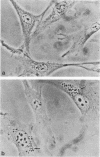Abstract
We evaluated P388D1 macrophagelike cells as model host cells for studying the intracellular survival and strain-specific virulence of Histoplasma capsulatum. Previously characterized strains which were virulent for mice destroyed monolayers of these cells within a few days. In contrast, related avirulent "smooth" variants failed to do so even after 20 days, although they persisted within P388D1 cells for at least 7 days. On the basis of this observation, we developed a quantitative radiolabel assay to use as an initial screen for virulence. Another cell type lining the respiratory tract was then examined as a potential host for H. capsulatum. Hamster trachea epithelial (HTE) cells readily internalized a variety of strains lacking alpha-(1,3)-glucan in their cell walls; however, the tracheal cells were only rarely infected by organisms possessing this polysaccharide. We subsequently inoculated HTE cells with alpha-(1,3)-glucan-positive strains and enriched for the few yeasts infecting these cells. The progeny resembled smooth variants in terms of colony morphology, the absence of alpha-(1,3)-glucan in their cell walls, and their inability to kill macrophages. Did the HTE cells select for these variant yeasts from the parent inoculum or instigate a change from the parental phenotype? Following a 3-h uptake period, only 2% of the ingested yeasts lacked alpha-(1,3)-glucan. One day later, nearly half of the intracellular organisms lacked this polymer. This rapid conversion of a large proportion of the inoculum suggests some type of environmentally triggered change, perhaps analogous to phase variation seen in many other pathogens. Infection of epithelial cells or some other nonprofessional phagocyte during natural histoplasmosis might give rise to similar variants, thus establishing a reservoir of organisms capable of causing chronic or latent infections.
Full text
PDF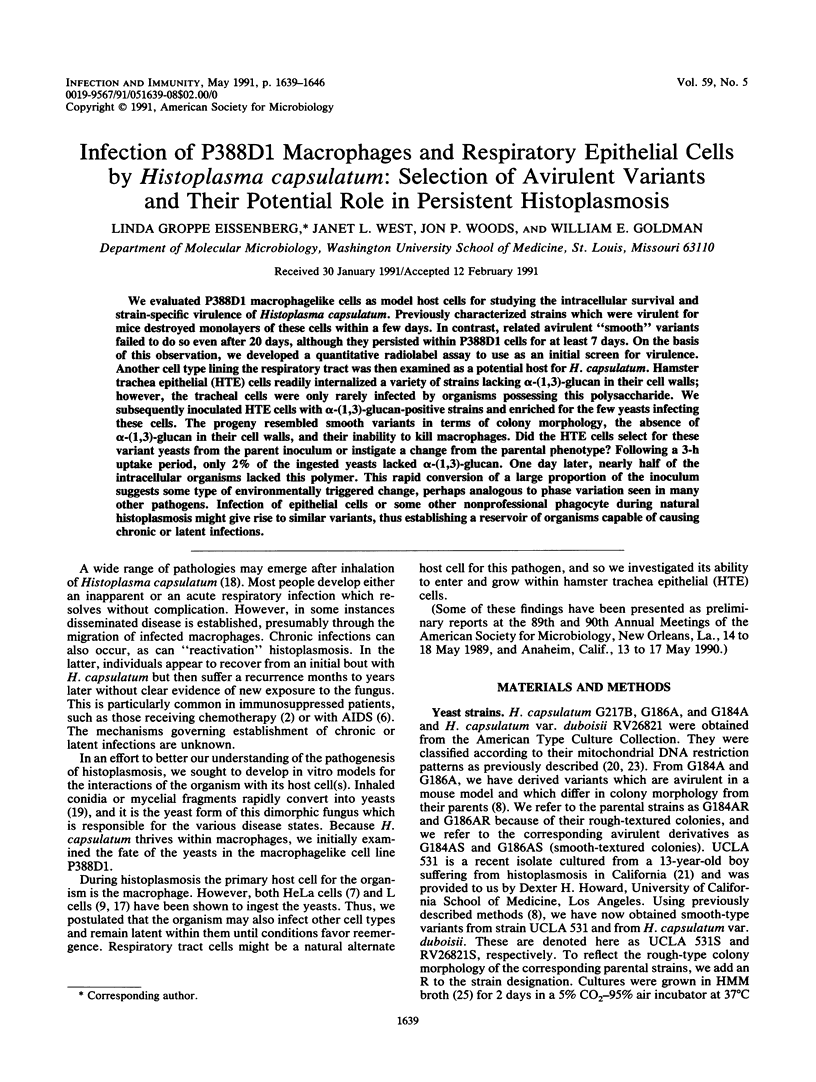
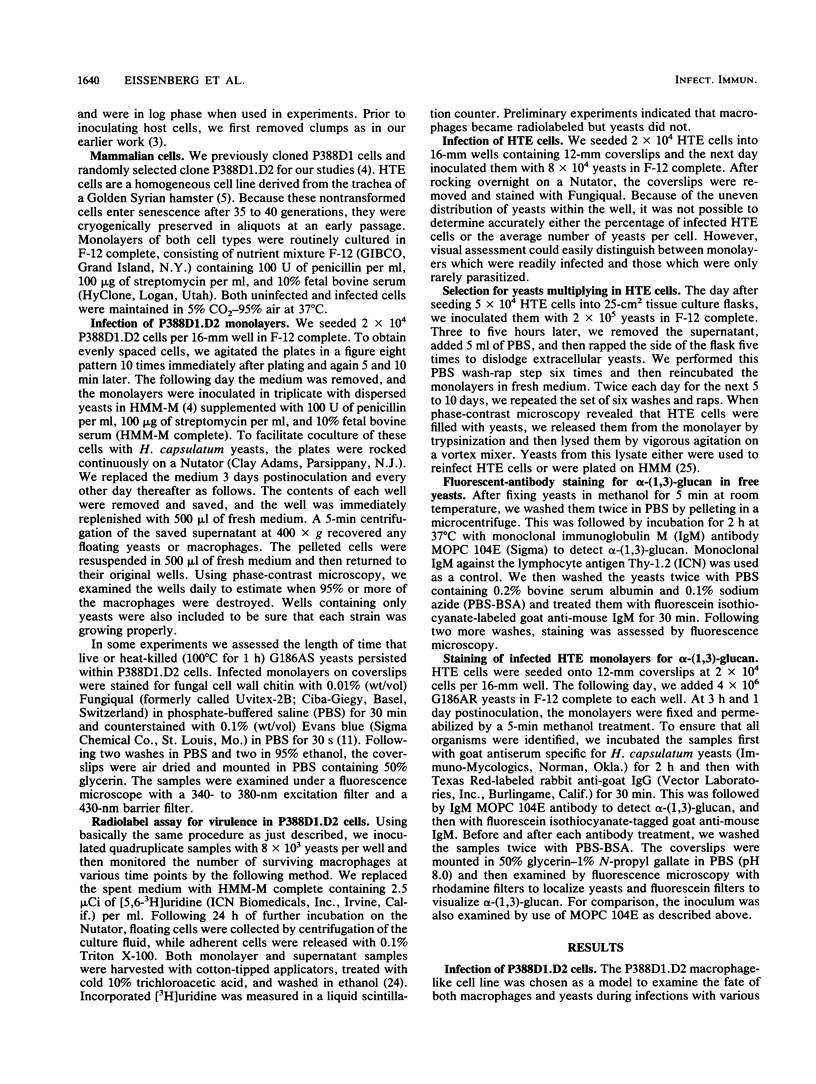
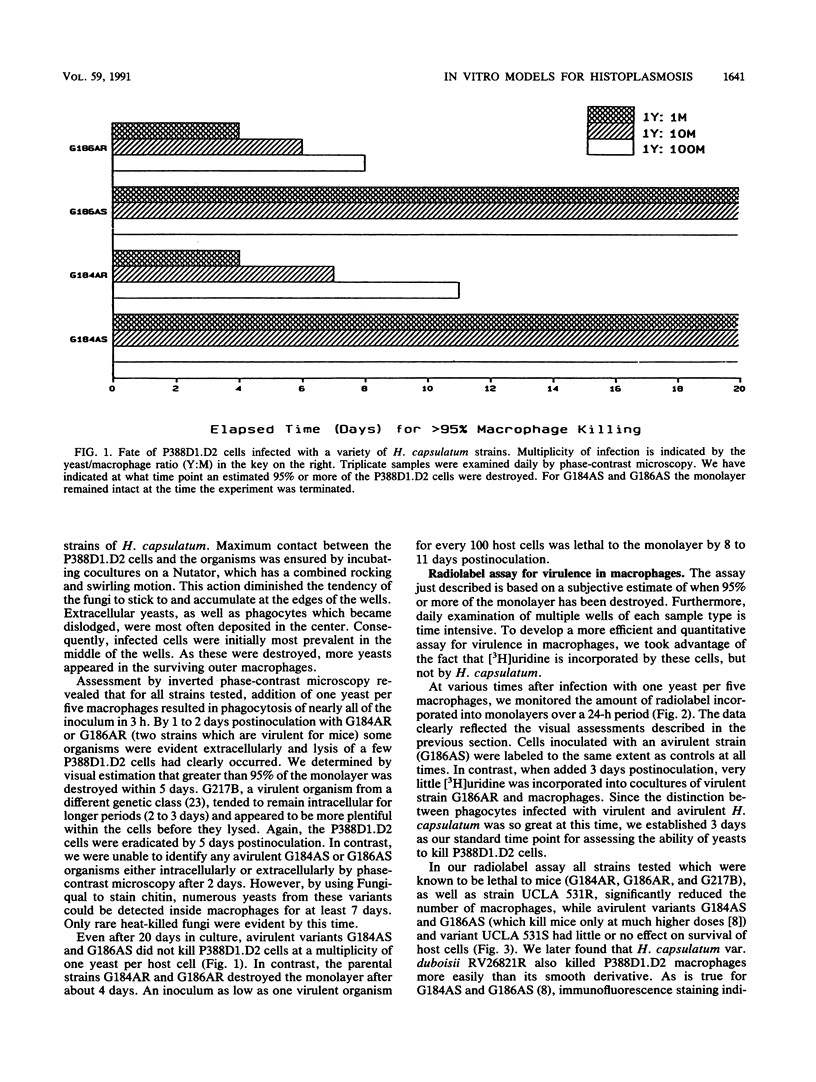
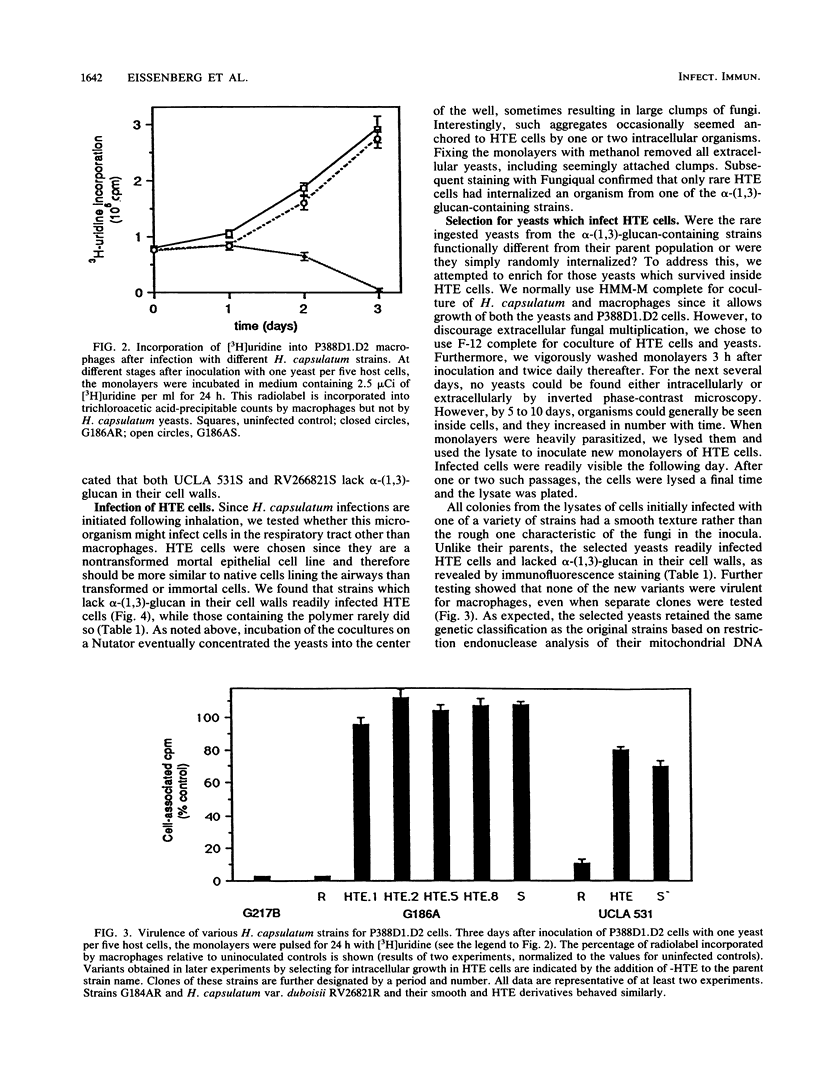
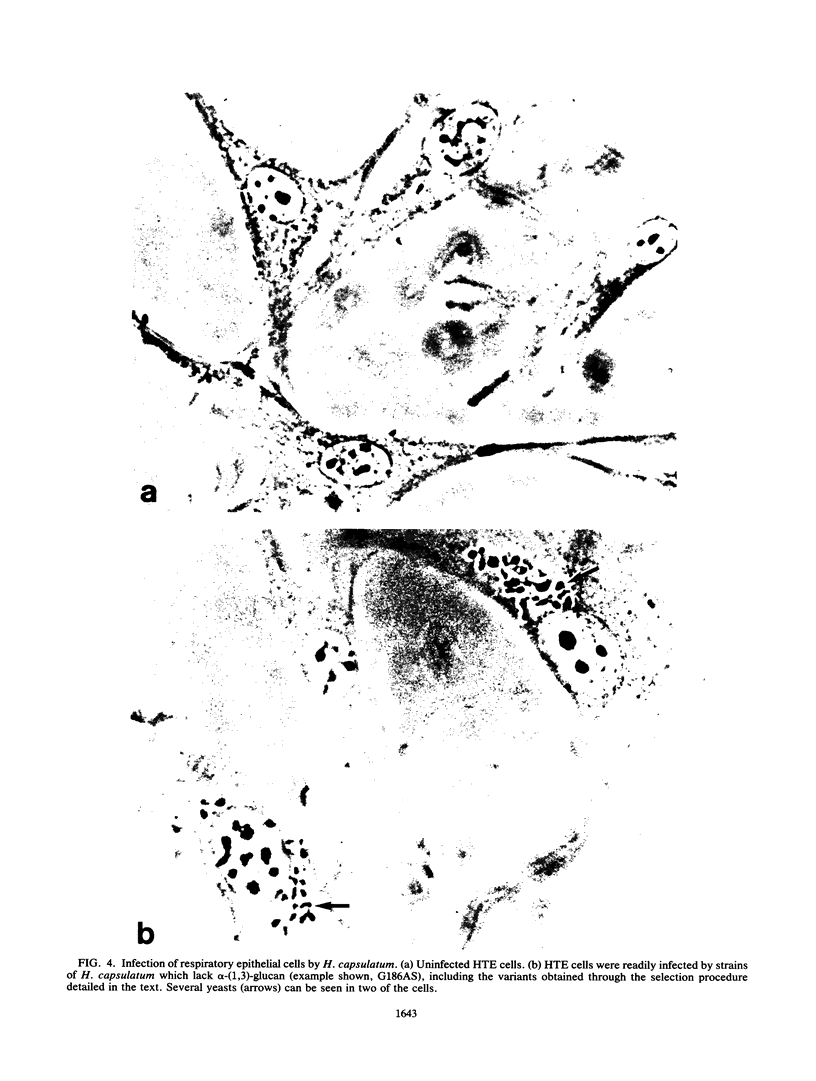
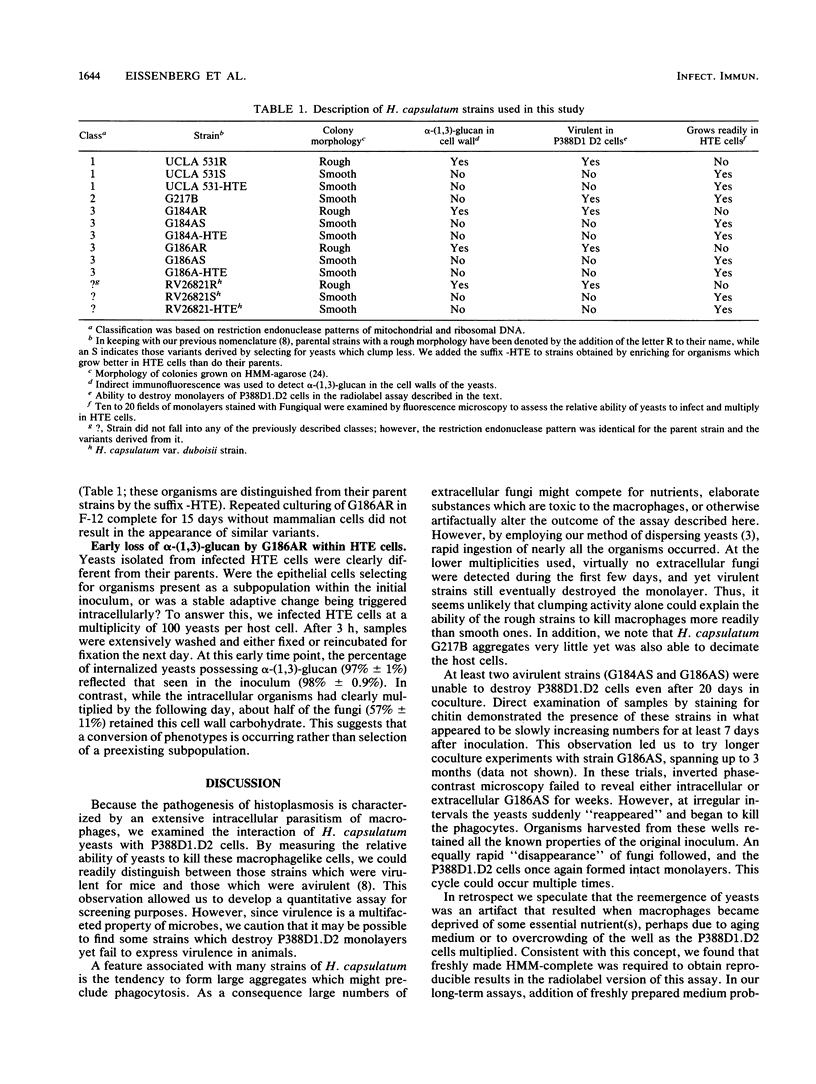
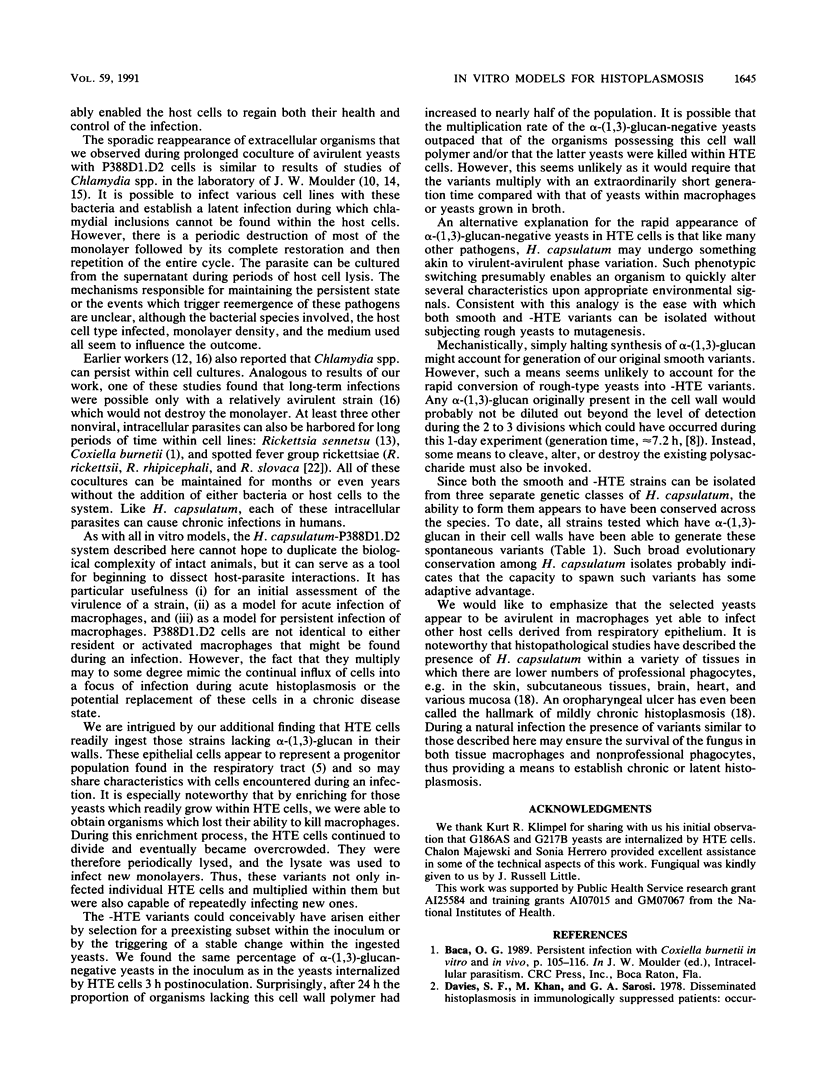
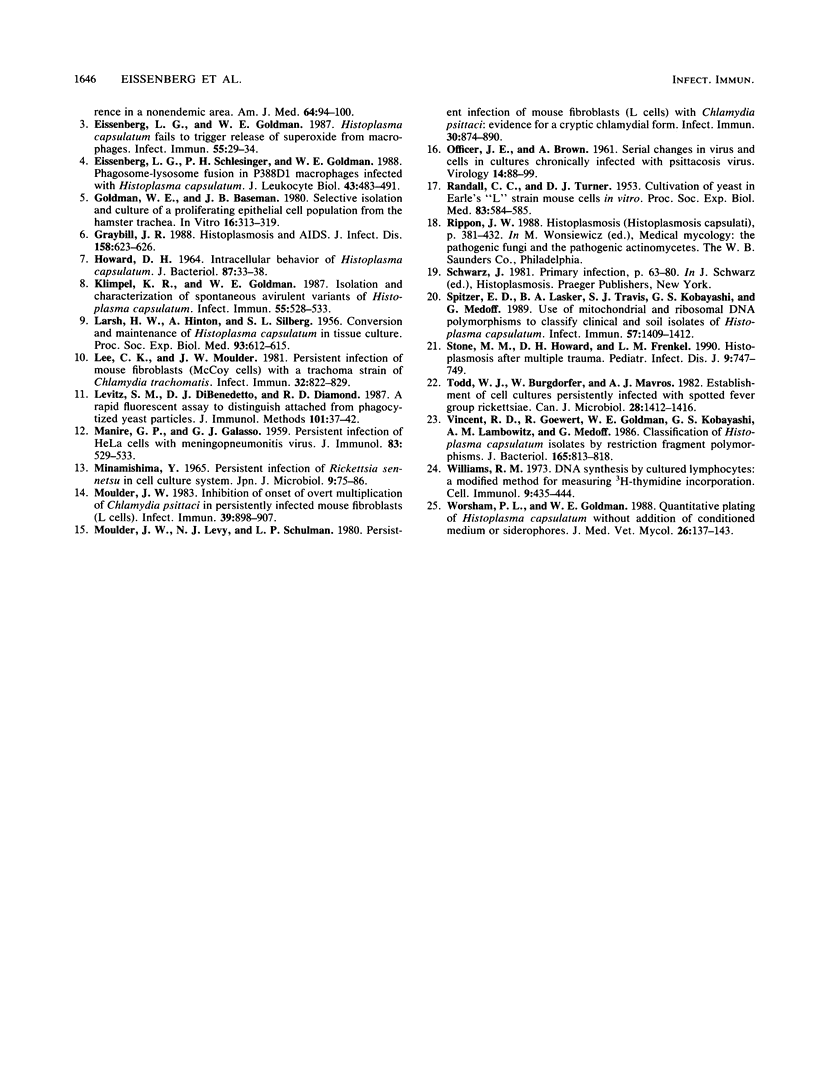
Images in this article
Selected References
These references are in PubMed. This may not be the complete list of references from this article.
- Eissenberg L. G., Goldman W. E. Histoplasma capsulatum fails to trigger release of superoxide from macrophages. Infect Immun. 1987 Jan;55(1):29–34. doi: 10.1128/iai.55.1.29-34.1987. [DOI] [PMC free article] [PubMed] [Google Scholar]
- Eissenberg L. G., Schlesinger P. H., Goldman W. E. Phagosome-lysosome fusion in P388D1 macrophages infected with Histoplasma capsulatum. J Leukoc Biol. 1988 Jun;43(6):483–491. doi: 10.1002/jlb.43.6.483. [DOI] [PubMed] [Google Scholar]
- Goldman W. E., Baseman J. B. Selective isolation and culture of a proliferating epithelial cell population from the hamster trachea. In Vitro. 1980 Apr;16(4):313–319. doi: 10.1007/BF02618337. [DOI] [PubMed] [Google Scholar]
- Graybill J. R. Histoplasmosis and AIDS. J Infect Dis. 1988 Sep;158(3):623–626. doi: 10.1093/infdis/158.3.623. [DOI] [PubMed] [Google Scholar]
- HINTON A., LARSH H. W., SILBERG S. L. Conversion and maintenance of Histoplasma capsulatum in tissue culture. Proc Soc Exp Biol Med. 1956 Dec;93(3):612–615. doi: 10.3181/00379727-93-22838. [DOI] [PubMed] [Google Scholar]
- HOWARD D. H. INTRACELLULAR BEHAVIOR OF HISTOPLASMA CAPSULATUM. J Bacteriol. 1964 Jan;87:33–38. doi: 10.1128/jb.87.1.33-38.1964. [DOI] [PMC free article] [PubMed] [Google Scholar]
- Klimpel K. R., Goldman W. E. Isolation and characterization of spontaneous avirulent variants of Histoplasma capsulatum. Infect Immun. 1987 Mar;55(3):528–533. doi: 10.1128/iai.55.3.528-533.1987. [DOI] [PMC free article] [PubMed] [Google Scholar]
- Lee C. K., Moulder J. W. Persistent infection of mouse fibroblasts (McCoy cells) with a trachoma strain of Chlamydia trachomatis. Infect Immun. 1981 May;32(2):822–829. doi: 10.1128/iai.32.2.822-829.1981. [DOI] [PMC free article] [PubMed] [Google Scholar]
- Levitz S. M., DiBenedetto D. J., Diamond R. D. A rapid fluorescent assay to distinguish attached from phagocytized yeast particles. J Immunol Methods. 1987 Jul 16;101(1):37–42. doi: 10.1016/0022-1759(87)90213-4. [DOI] [PubMed] [Google Scholar]
- MANIRE G. P., GALASSO G. J. Persistent infection of HeLa cells with meningopneumonitis virus. J Immunol. 1959 Nov;83:529–533. [PubMed] [Google Scholar]
- Minamishima Y. Persistent infection of Rickettsia sennetsu in cell culture system. Jpn J Microbiol. 1965 Jun;9(2):75–86. doi: 10.1111/j.1348-0421.1965.tb00277.x. [DOI] [PubMed] [Google Scholar]
- Moulder J. W. Inhibition of onset of overt multiplication of Chlamydia psittaci in persistently infected mouse fibroblasts (L cells). Infect Immun. 1983 Feb;39(2):898–907. doi: 10.1128/iai.39.2.898-907.1983. [DOI] [PMC free article] [PubMed] [Google Scholar]
- Moulder J. W., Levy N. J., Schulman L. P. Persistent infection of mouse fibroblasts (L cells) with Chlamydia psittaci: evidence for a cryptic chlamydial form. Infect Immun. 1980 Dec;30(3):874–883. doi: 10.1128/iai.30.3.874-883.1980. [DOI] [PMC free article] [PubMed] [Google Scholar]
- OFFICER J. E., BROWN A. Serial changes in virus and cells in cultures chronically infected with psittacosis virus. Virology. 1961 May;14:88–99. doi: 10.1016/0042-6822(61)90136-2. [DOI] [PubMed] [Google Scholar]
- RANDALL C. C., TURNER D. J. Cultivation of yeast in Earle's L strain mouse cells in vitro. Proc Soc Exp Biol Med. 1953 Jul;83(3):584–585. doi: 10.3181/00379727-83-20425. [DOI] [PubMed] [Google Scholar]
- Spitzer E. D., Lasker B. A., Travis S. J., Kobayashi G. S., Medoff G. Use of mitochondrial and ribosomal DNA polymorphisms to classify clinical and soil isolates of Histoplasma capsulatum. Infect Immun. 1989 May;57(5):1409–1412. doi: 10.1128/iai.57.5.1409-1412.1989. [DOI] [PMC free article] [PubMed] [Google Scholar]
- Stone M. M., Frenkel L. M., Howard D. H. Histoplasmosis after multiple trauma. Pediatr Infect Dis J. 1990 Oct;9(10):747–749. [PubMed] [Google Scholar]
- Todd W. J., Burgdorfer W., Mavros A. J. Establishment of cell cultures persistently infected with spotted fever group rickettsiae. Can J Microbiol. 1982 Dec;28(12):1412–1416. doi: 10.1139/m82-212. [DOI] [PubMed] [Google Scholar]
- Vincent R. D., Goewert R., Goldman W. E., Kobayashi G. S., Lambowitz A. M., Medoff G. Classification of Histoplasma capsulatum isolates by restriction fragment polymorphisms. J Bacteriol. 1986 Mar;165(3):813–818. doi: 10.1128/jb.165.3.813-818.1986. [DOI] [PMC free article] [PubMed] [Google Scholar]
- Williams R. M. DNA synthesis by cultured lymphocytes: a modified method for measuring 3H-thymidine incorporation. Cell Immunol. 1973 Dec;9(3):435–444. doi: 10.1016/0008-8749(73)90058-0. [DOI] [PubMed] [Google Scholar]
- Worsham P. L., Goldman W. E. Quantitative plating of Histoplasma capsulatum without addition of conditioned medium or siderophores. J Med Vet Mycol. 1988 Jun;26(3):137–143. [PubMed] [Google Scholar]



